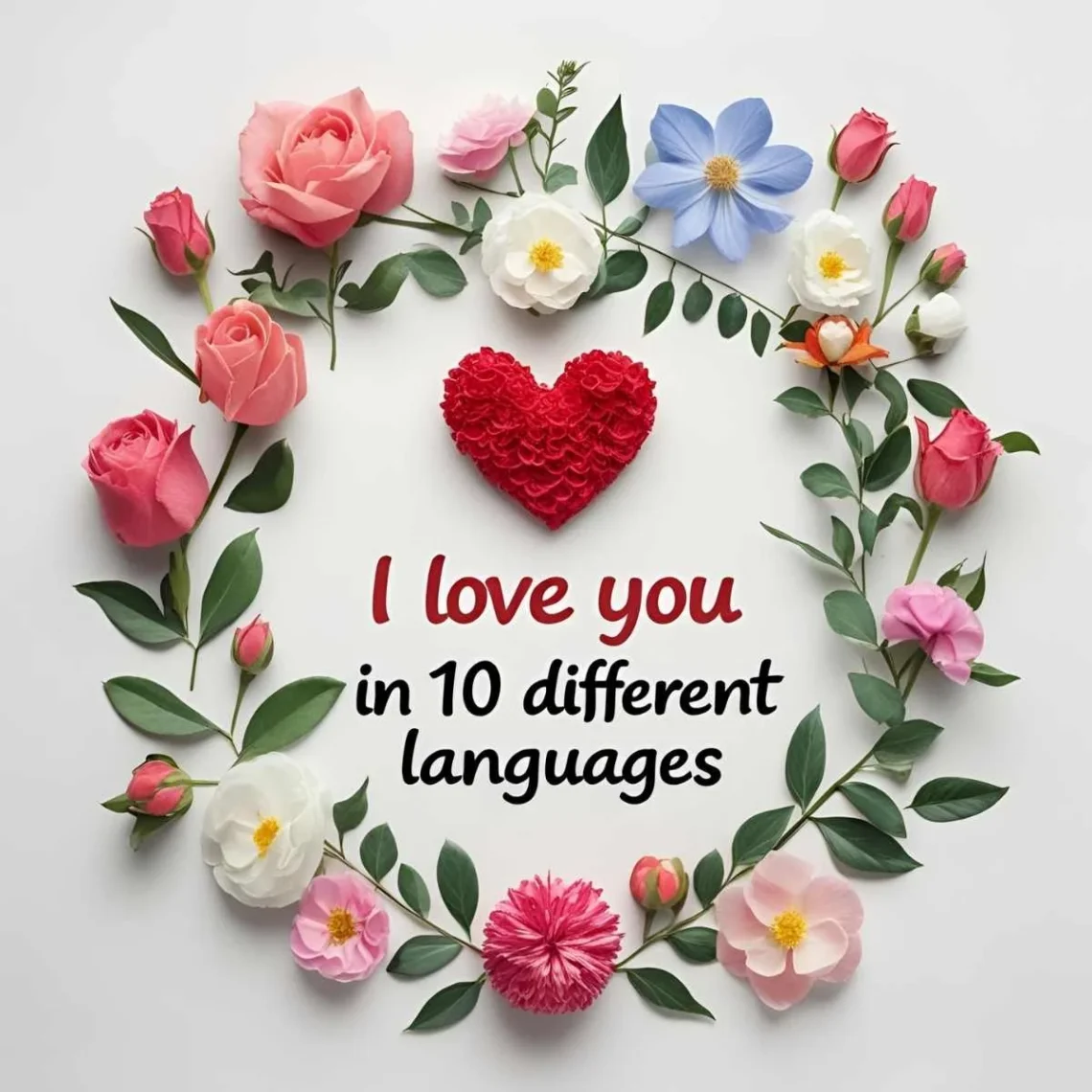Picture a quiet moment on a Parisian bridge, where a whispered “je t’aime” seals a lifelong promise. Those three words, “I love you,” carry a universal heartbeat, yet they transform across languages and cultures.
Whether it’s a heartfelt “te amo” in a Mexican plaza or a soft “aishiteru” in a Tokyo garden, this phrase captures the essence of human connection, shaped by each culture’s unique expression of love.
Let’s embark on a global journey to explore how people say “I love you” in different languages and what these words reveal about their societies.
Reference Table: “I Love You” in Different Languages
| Language | Word/Phrase | Cultural/Linguistic Insight |
|---|---|---|
| French | Je t’aime | A tender, poetic declaration, often used romantically. |
| Spanish | Te amo | Passionate and direct, common in Spain and Latin America. |
| Italian | Ti amo | Reserved for deep romantic love, distinct from friendship. |
| German | Ich liebe dich | Straightforward and sincere, reflecting German directness. |
| Mandarin | Wǒ ài nǐ (我爱你) | Rare but powerful, used for profound romantic feelings. |
| Hindi | Main tumse pyar karta hoon | Gender-specific, evoking Bollywood’s romantic intensity. |
| Japanese | Aishiteru (愛してる) | Reserved for serious commitment, rarely used casually. |
| Korean | Saranghae (사랑해) | Warm and versatile, used in both casual and deep contexts. |
| Arabic | Uḥibbuk (أحبك) | Poetic and emotional, used across 20+ countries. |
| Swahili | Nakupenda | A warm, inclusive term used in East African communities. |
European Languages: Passionate Declarations of Love
European languages express “I love you” with a blend of romance and sincerity. For instance, in French, “je t’aime” is a poetic whisper, often heard in romantic settings like Parisian cafés, reflecting France’s love for elegance. Meanwhile, Spanish speakers say “te amo,” a passionate declaration used across Spain and Latin America, often paired with grand gestures. Additionally, Italian uses “ti amo,” reserved for deep romantic love, distinct from “ti voglio bene” for friends or family, showing Italy’s emphasis on emotional precision. In German, “ich liebe dich” is direct and heartfelt, mirroring the culture’s straightforward approach. Thus, these phrases reflect Europe’s range, from poetic French to pragmatic German, each carrying deep emotional weight.
Asian Languages: Subtle and Profound Expressions
Asia’s linguistic diversity shapes unique ways to say “I love you,” often tied to cultural restraint or passion. For example, in Mandarin, “wǒ ài nǐ” is rarely spoken due to its intensity, reserved for serious commitments in China’s reserved culture. In Hindi, “main tumse pyar karta hoon” (for men) or “karti hoon” (for women) is vibrant, evoking Bollywood’s dramatic romances, used widely in India. Similarly, Japanese “aishiteru” is a rare, powerful declaration, often saved for lifelong partners, reflecting Japan’s subtle emotional expression. In Korean, “saranghae” is versatile, used casually or deeply, aligning with South Korea’s emotional openness. Finally, Arabic’s “uḥibbuk,” spoken in over 20 countries like Egypt and Lebanon, carries poetic depth, rooted in the region’s literary heritage. These terms highlight Asia’s spectrum, from restrained Japanese to expressive Hindi and Arabic.
African Languages: Love in Communal Warmth
In African languages, “I love you” often reflects community and emotional warmth. For instance, Swahili, spoken in over 20 countries like Kenya and Tanzania, uses “nakupenda,” a heartfelt term that conveys affection in both romantic and familial contexts. This inclusive phrase is often shared in vibrant community settings, emphasizing East Africa’s communal spirit. Other African languages, like Zulu or Yoruba, may use descriptive phrases rather than direct translations, often embedding love within cultural expressions of care and unity, reflecting the continent’s focus on collective bonds.
Indigenous & Island Languages: Intimate Bonds of Affection
Indigenous and island languages express “I love you” with intimacy and cultural depth. For example, in Maori, spoken in New Zealand, “aroha atu” conveys deep love, often tied to family and community, reflecting the culture’s holistic view of affection. In Hawaiian, “aloha au iā ʻoe” carries the spirit of aloha, blending romantic and communal love, used in warm, island settings. Similarly, Cherokee uses phrases like “gvgeyu’i,” a term for deep affection, spoken in Native American communities to express enduring bonds. In Samoan, “ou te alofa ia te oe” reflects the Pacific’s communal values, often shared in group celebrations. Across these cultures, from New Zealand to the Cherokee Nation, the phrase emphasizes connection, often tied to shared rituals.
Cultural Insights: The Evolution of Love’s Expression
The phrase “I love you” has evolved with cultural shifts. In ancient Latin, “ego te amo” laid the foundation for Romance languages like Spanish and Italian. In Arabic, “uḥibbuk” traces back to medieval poetry, shaping its modern use across the Middle East. Moreover, in African cultures, terms like “nakupenda” reflect oral traditions that value community over基本的には、集団的な愛情を表す。 In Asia, phrases like “wǒ ài nǐ” emerged with modern romantic ideals, influenced by cultural shifts toward individual expression. These words carry centuries of history, from European courtly love to Pacific communal bonds, uniting humanity through shared affection.
Proverbs and Sayings: Wisdom of Love
- French: “L’amour est un mystère.” (Love is a mystery.) – Reflects the enigmatic nature of love.
- Hindi: “Pyar dil se dil tak jata hai.” (Love travels from heart to heart.) – Emphasizes emotional connection.
- Swahili: “Penzi ni nguvu ya maisha.” (Love is the strength of life.) – Ties love to vitality.
- Japanese: “Ai wa subete o norikoeru.” (Love overcomes all.) – Highlights love’s resilience.
- Spanish: “El amor todo lo puede.” (Love can do anything.) – Celebrates love’s boundless power.
FAQs
Why are some “I love you” phrases similar?
Shared linguistic roots, like Latin for Romance languages, and cultural exchanges, like Arabic’s influence on Swahili, create similarities.
What’s the oldest term for “I love you”?
Latin’s “ego te amo” (circa 1st century BCE) is among the earliest, influencing modern Romance languages.
How do cultures shape the phrase’s use?
Collectivist cultures (e.g., African, Indigenous) emphasize communal love, while individualistic cultures (e.g., European) focus on personal romance.
Conclusion
From “je t’aime” in France to “nakupenda” in Tanzania, “I love you” weaves a global tapestry of affection. Each phrase, whether the intense “aishiteru” in Japanese or the warm “aloha au iā ʻoe” in Hawaiian, reflects cultural values while celebrating love’s universal power. Consequently, these words unite all people in a shared language of the heart. How do you say “I love you” in your language, and what does it mean to you? Share your stories below—we’d love to hear your voice!





